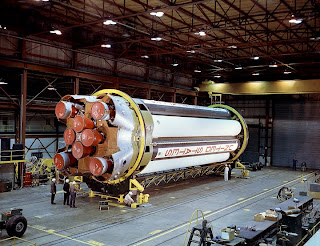
Launch of a military Atlas rocket.
From late September to mid October in 1961, there continued a number of tests from the Atlantic Missile Range at Cape Canaveral as the US Air Force worked to improve our strategic missiles. What an exciting time it must have been for the citizens living along the Florida Coast as launch after launch lifted off from the beaches out over the Atlantic Ocean. Besides the notable large rocket launches, there were also small sounding rockets and scientific payloads being tested.
On October 5, 1961 the USAF fired an Atlas ICBM with a dummy warhead over the Atlantic. Flying over 9,000 miles from its launch pad, a data capsule also loaded on top of the rocket safely landed in the waters and was recovered. Although this was a military launch, every use of an Atlas rocket was carefully analyzed for the impact it might have on the upcoming launch of an astronaut into orbit. Remember, the Atlas did not have too stellar a reputation among the Mercury 7 astronauts who had seen a number of these rockets explode.
On October 6, 1961, the USAF launched a Titan I rocket with the mission to test the Titan II guidance system.

Titan 1a.
This early testing of the Titan ICBM was primarily for development of our strategic rocket forces, but once again, the data gained by these tests would have their impact on the manned space program later in the Gemini Program.

Argo D4. Sounds like a Star Wars Droid to me.
Launches didn't only blast off from Cape Canaveral. From NASA's Wallops island facility, sounding rockets like the Argo lifted scientific experiments to learn the effect that electricity plays in the upper atmosphere.
On October 13th, The USAF launched another in its series of Discoverer secret missions. Discoverer 32 lifted off carrying the Agena stage (used as a satellite or stage to carry experiments). Its mission was to improve the space maneuvering capabilities of the Agena craft, test new materials for radiation shielding, and perform some surveillance experiments.

Agena stage.
Discoverer 32 lifted off from Vandenberg AF Base in California. After placing the Agena craft in space, controllers went through their tests and experiments without mishap. On this trip, the Thor rocket made its 100th successful launch!

Thor-Agena rocket at Vandenberg AF Base.
After one day of orbiting, the Agena spacecraft ejected a 300-pound capsule which re-entered the atmosphere, and was recovered off the coast of Hawaii. As it parachuted to the ground, a specially-prepared cargo plane snatched it in mid-air for a secret trip back to base.

Gotcha!
Once safely back at the USAF base, the data from the launch stored in the capsule was carefully examined. Only one thing went wrong on this flight. When the technicians examined the large roll of film used to picture our enemies' secret locations, they discovered that 96% of the pictures had been taken out of focus. And you thought YOU've taken bad pictures before...



































